Analyzing Leadership Theories and Practices
VerifiedAdded on 2020/04/21
|16
|4209
|55
AI Summary
This assignment delves into the world of leadership theory and practice. Students are tasked with analyzing a range of leadership theories, understanding their origins and key concepts. The focus extends to practical application, requiring students to examine case studies and critically evaluate how different leadership styles influence organizational dynamics. Additionally, the assignment emphasizes ethical considerations in leadership, prompting reflection on responsible and effective leadership practices.
Contribute Materials
Your contribution can guide someone’s learning journey. Share your
documents today.
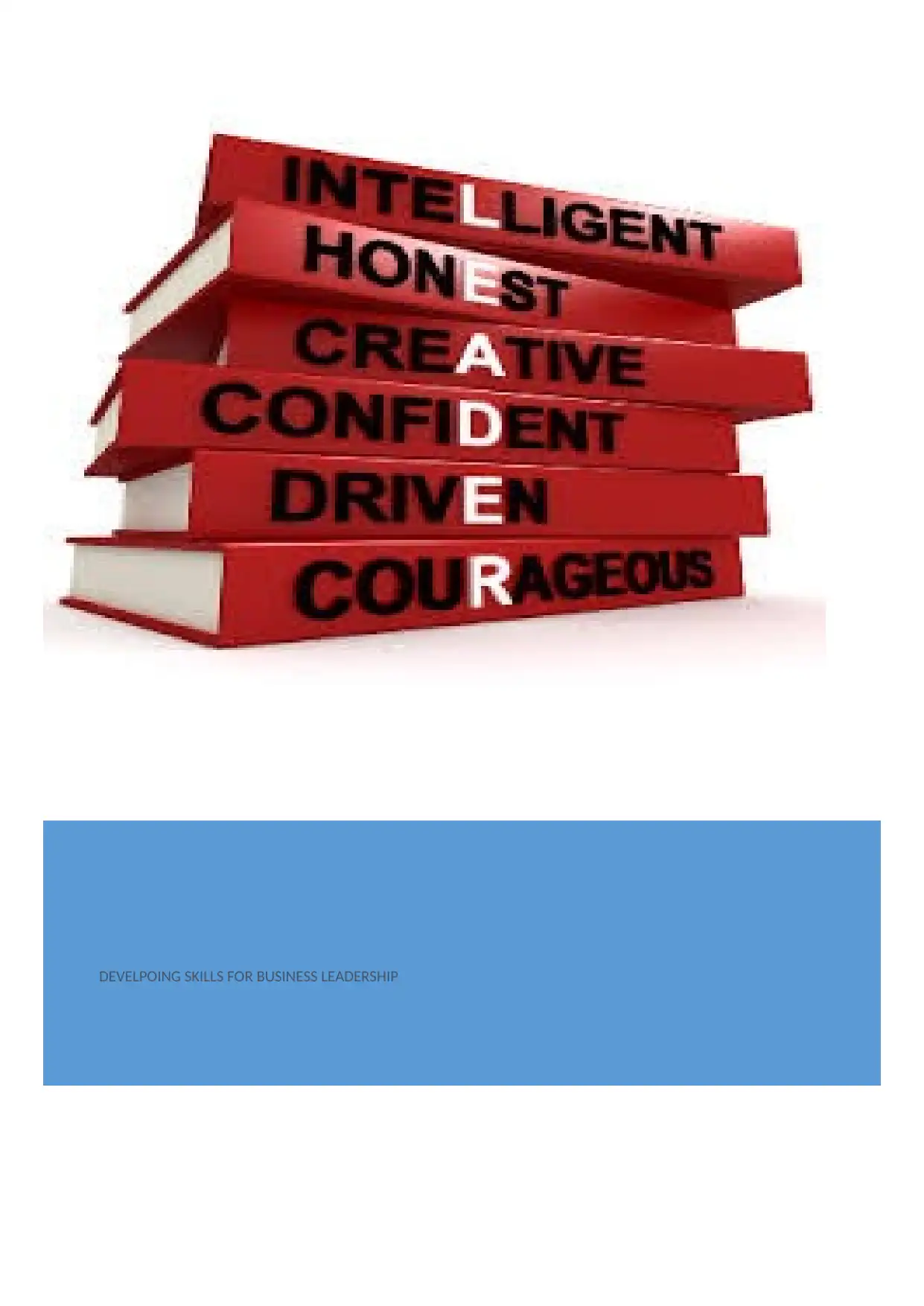
DEVELPOING SKILLS FOR BUSINESS LEADERSHIP
Secure Best Marks with AI Grader
Need help grading? Try our AI Grader for instant feedback on your assignments.

Introduction
A person who has ability to inspire others to work, so that organisation can attain its
objectives is considered as a leader (Chhokar et.al. 2013). I think, true leader is the one who
can stand alone and take all the decision on the basis of its group members. It is not easy for
everyone to become a leader. There are some set of traits as well as qualities needed to attain
this position (Winston, Creame and Miller, 2013).
One of the most popular model is ADDIE, which was developed in the year 1975 by
Florida University (Jones, (2014) and helped me at many stages to become good leader. It is
widely used by in structural designers to provide tanning to new comers. This is used for
preparing step by step procedure which helps in making complete training programme. As,
per me it’s a best model because it involve five different phases which act as a base for
perform the task on the basis of certain standards that are establish to ensure uniformity in the
course of actions (Reiser and Dempsey, 2012).
As a leader, I am providing complete the support to my team member wherever, they
required my help. In the beginning it was not easy for me because I was lacking behind in
leadership knowledge, but gradually with the help of ADDIE I learned to how to manage
things, motivate, supervise, inspire and how to build a confidence in my team (Gardiner,
A person who has ability to inspire others to work, so that organisation can attain its
objectives is considered as a leader (Chhokar et.al. 2013). I think, true leader is the one who
can stand alone and take all the decision on the basis of its group members. It is not easy for
everyone to become a leader. There are some set of traits as well as qualities needed to attain
this position (Winston, Creame and Miller, 2013).
One of the most popular model is ADDIE, which was developed in the year 1975 by
Florida University (Jones, (2014) and helped me at many stages to become good leader. It is
widely used by in structural designers to provide tanning to new comers. This is used for
preparing step by step procedure which helps in making complete training programme. As,
per me it’s a best model because it involve five different phases which act as a base for
perform the task on the basis of certain standards that are establish to ensure uniformity in the
course of actions (Reiser and Dempsey, 2012).
As a leader, I am providing complete the support to my team member wherever, they
required my help. In the beginning it was not easy for me because I was lacking behind in
leadership knowledge, but gradually with the help of ADDIE I learned to how to manage
things, motivate, supervise, inspire and how to build a confidence in my team (Gardiner,
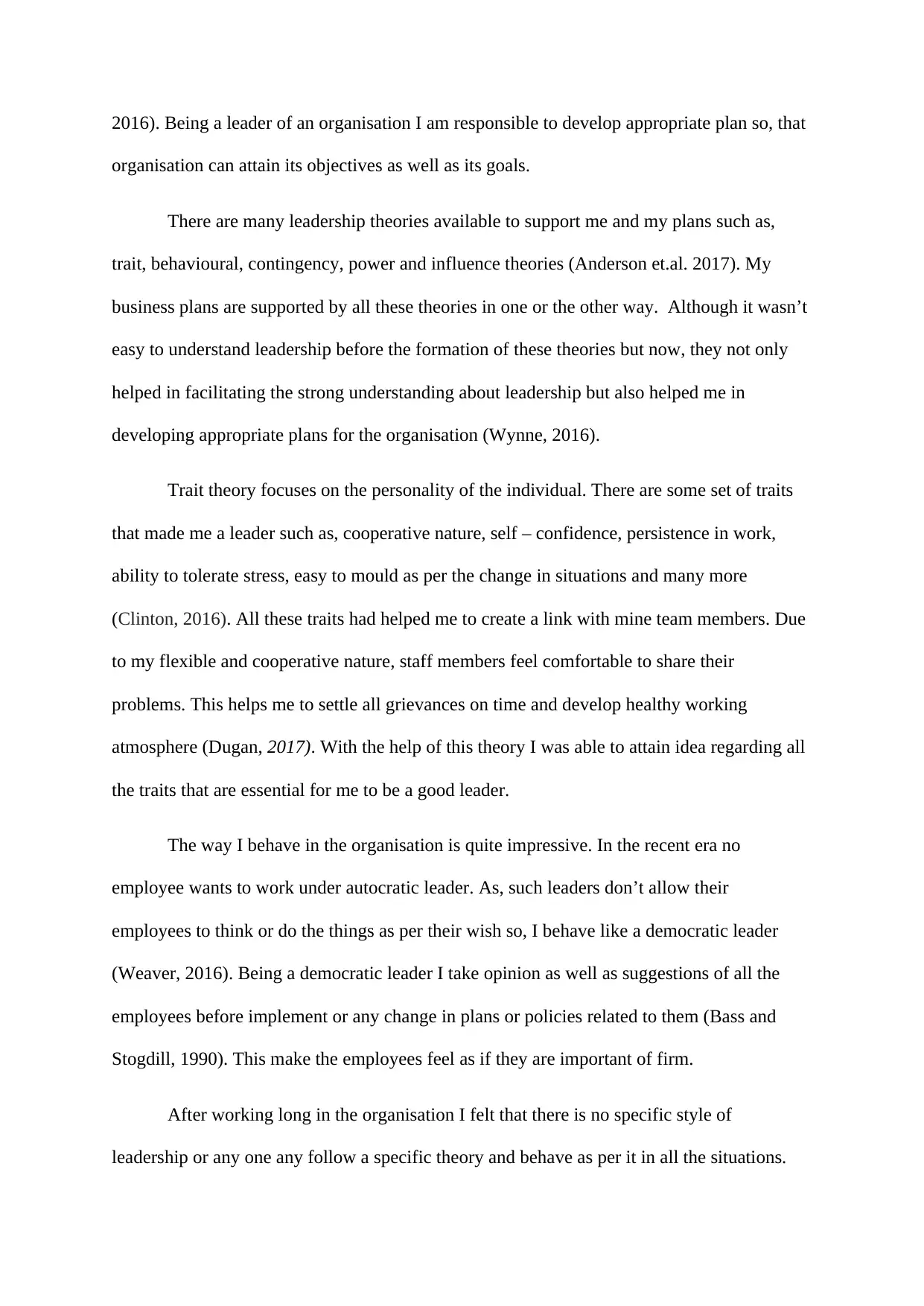
2016). Being a leader of an organisation I am responsible to develop appropriate plan so, that
organisation can attain its objectives as well as its goals.
There are many leadership theories available to support me and my plans such as,
trait, behavioural, contingency, power and influence theories (Anderson et.al. 2017). My
business plans are supported by all these theories in one or the other way. Although it wasn’t
easy to understand leadership before the formation of these theories but now, they not only
helped in facilitating the strong understanding about leadership but also helped me in
developing appropriate plans for the organisation (Wynne, 2016).
Trait theory focuses on the personality of the individual. There are some set of traits
that made me a leader such as, cooperative nature, self – confidence, persistence in work,
ability to tolerate stress, easy to mould as per the change in situations and many more
(Clinton, 2016). All these traits had helped me to create a link with mine team members. Due
to my flexible and cooperative nature, staff members feel comfortable to share their
problems. This helps me to settle all grievances on time and develop healthy working
atmosphere (Dugan, 2017). With the help of this theory I was able to attain idea regarding all
the traits that are essential for me to be a good leader.
The way I behave in the organisation is quite impressive. In the recent era no
employee wants to work under autocratic leader. As, such leaders don’t allow their
employees to think or do the things as per their wish so, I behave like a democratic leader
(Weaver, 2016). Being a democratic leader I take opinion as well as suggestions of all the
employees before implement or any change in plans or policies related to them (Bass and
Stogdill, 1990). This make the employees feel as if they are important of firm.
After working long in the organisation I felt that there is no specific style of
leadership or any one any follow a specific theory and behave as per it in all the situations.
organisation can attain its objectives as well as its goals.
There are many leadership theories available to support me and my plans such as,
trait, behavioural, contingency, power and influence theories (Anderson et.al. 2017). My
business plans are supported by all these theories in one or the other way. Although it wasn’t
easy to understand leadership before the formation of these theories but now, they not only
helped in facilitating the strong understanding about leadership but also helped me in
developing appropriate plans for the organisation (Wynne, 2016).
Trait theory focuses on the personality of the individual. There are some set of traits
that made me a leader such as, cooperative nature, self – confidence, persistence in work,
ability to tolerate stress, easy to mould as per the change in situations and many more
(Clinton, 2016). All these traits had helped me to create a link with mine team members. Due
to my flexible and cooperative nature, staff members feel comfortable to share their
problems. This helps me to settle all grievances on time and develop healthy working
atmosphere (Dugan, 2017). With the help of this theory I was able to attain idea regarding all
the traits that are essential for me to be a good leader.
The way I behave in the organisation is quite impressive. In the recent era no
employee wants to work under autocratic leader. As, such leaders don’t allow their
employees to think or do the things as per their wish so, I behave like a democratic leader
(Weaver, 2016). Being a democratic leader I take opinion as well as suggestions of all the
employees before implement or any change in plans or policies related to them (Bass and
Stogdill, 1990). This make the employees feel as if they are important of firm.
After working long in the organisation I felt that there is no specific style of
leadership or any one any follow a specific theory and behave as per it in all the situations.

There are many different situations so, the best leader is the one who can mould himself as
per the scenario.
Apart from the general way of working at the time of providing training of
instructional designs, I try to give leaner proper freedom especially at the time of online
learning. Whereas, control I can be established over their thinking when face to face training
is given (Branc, 2009) I adopted this theory because it provide freedom to all staff member to
build their own thinking and understanding. Along with this, employees are also encourage to
give their opinion on the experience that they attain during programme.
Major reason because of which I think ADDIE is the best are- employees can actively
involve, learn things by developing their own understanding in spite of memorization and this
will overall enhance their communication skills (Davis, 2013). All these things helps
employee to open up with other organisational member, which further reduce their hesitations
(Quinones and Ehrenstein, 2010).
Once the employees are comfortable enough to work in the new organisation, they are
provided training. Although there are many methods of training such as, lecturing, role
playing, group discussion and by performing many leadership activities (Jackson and Parry,
2011).
In my organisation, trainers use lecturing and interactive methods for the purpose of
providing training. Under lecturing method, employees are verbally explained the work that
they have to perform in the organisation. On the basis of the experience experts provide
complete knowledge regarding the work they have to perform (Marks et.al. 2014). This
method is considered most suitable because it, helps in resolving all conflicts, issue and
problems of employees. Some time as per my instructions printed papers which contain detail
per the scenario.
Apart from the general way of working at the time of providing training of
instructional designs, I try to give leaner proper freedom especially at the time of online
learning. Whereas, control I can be established over their thinking when face to face training
is given (Branc, 2009) I adopted this theory because it provide freedom to all staff member to
build their own thinking and understanding. Along with this, employees are also encourage to
give their opinion on the experience that they attain during programme.
Major reason because of which I think ADDIE is the best are- employees can actively
involve, learn things by developing their own understanding in spite of memorization and this
will overall enhance their communication skills (Davis, 2013). All these things helps
employee to open up with other organisational member, which further reduce their hesitations
(Quinones and Ehrenstein, 2010).
Once the employees are comfortable enough to work in the new organisation, they are
provided training. Although there are many methods of training such as, lecturing, role
playing, group discussion and by performing many leadership activities (Jackson and Parry,
2011).
In my organisation, trainers use lecturing and interactive methods for the purpose of
providing training. Under lecturing method, employees are verbally explained the work that
they have to perform in the organisation. On the basis of the experience experts provide
complete knowledge regarding the work they have to perform (Marks et.al. 2014). This
method is considered most suitable because it, helps in resolving all conflicts, issue and
problems of employees. Some time as per my instructions printed papers which contain detail
Secure Best Marks with AI Grader
Need help grading? Try our AI Grader for instant feedback on your assignments.
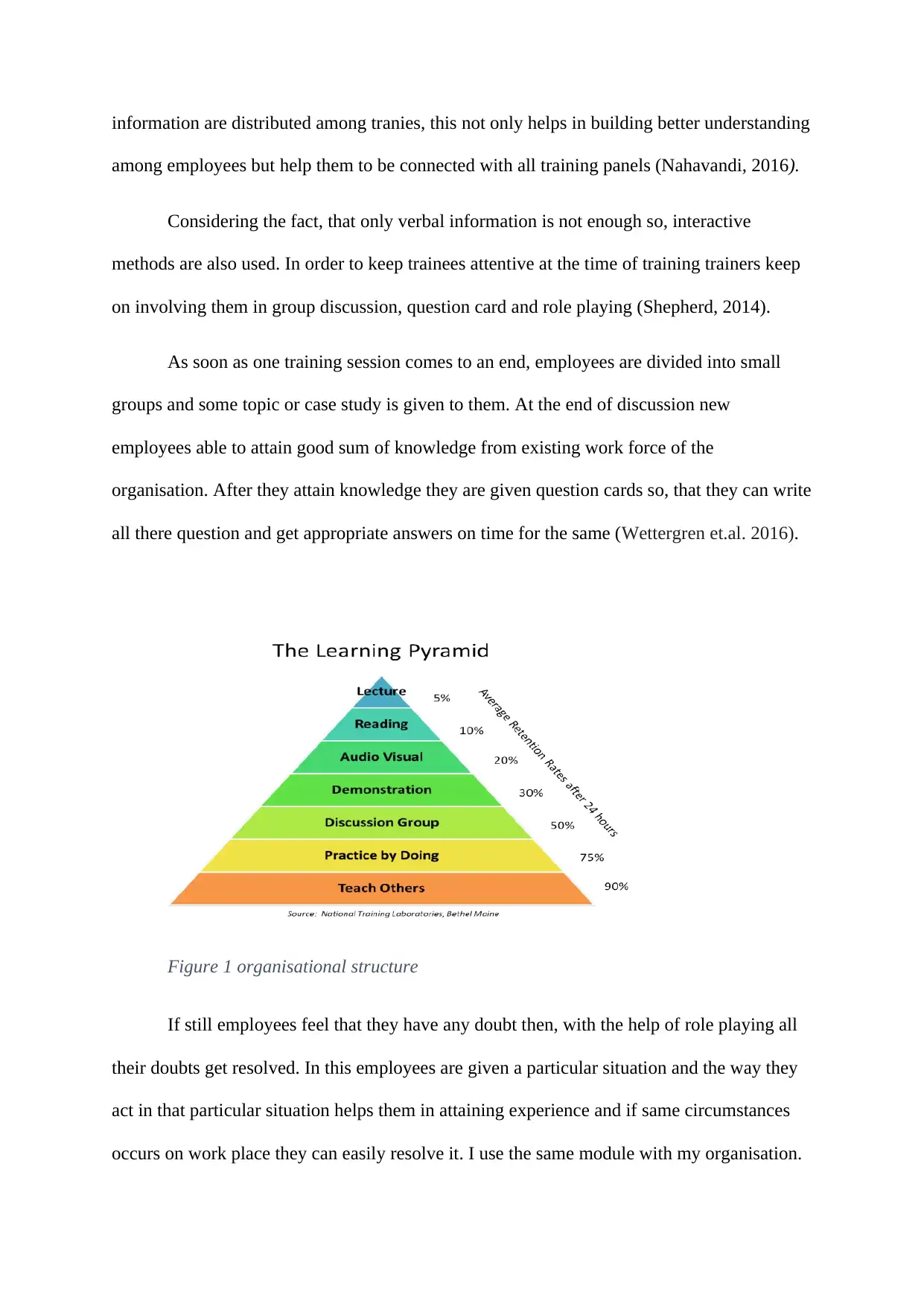
information are distributed among tranies, this not only helps in building better understanding
among employees but help them to be connected with all training panels (Nahavandi, 2016).
Considering the fact, that only verbal information is not enough so, interactive
methods are also used. In order to keep trainees attentive at the time of training trainers keep
on involving them in group discussion, question card and role playing (Shepherd, 2014).
As soon as one training session comes to an end, employees are divided into small
groups and some topic or case study is given to them. At the end of discussion new
employees able to attain good sum of knowledge from existing work force of the
organisation. After they attain knowledge they are given question cards so, that they can write
all there question and get appropriate answers on time for the same (Wettergren et.al. 2016).
Figure 1 organisational structure
If still employees feel that they have any doubt then, with the help of role playing all
their doubts get resolved. In this employees are given a particular situation and the way they
act in that particular situation helps them in attaining experience and if same circumstances
occurs on work place they can easily resolve it. I use the same module with my organisation.
among employees but help them to be connected with all training panels (Nahavandi, 2016).
Considering the fact, that only verbal information is not enough so, interactive
methods are also used. In order to keep trainees attentive at the time of training trainers keep
on involving them in group discussion, question card and role playing (Shepherd, 2014).
As soon as one training session comes to an end, employees are divided into small
groups and some topic or case study is given to them. At the end of discussion new
employees able to attain good sum of knowledge from existing work force of the
organisation. After they attain knowledge they are given question cards so, that they can write
all there question and get appropriate answers on time for the same (Wettergren et.al. 2016).
Figure 1 organisational structure
If still employees feel that they have any doubt then, with the help of role playing all
their doubts get resolved. In this employees are given a particular situation and the way they
act in that particular situation helps them in attaining experience and if same circumstances
occurs on work place they can easily resolve it. I use the same module with my organisation.
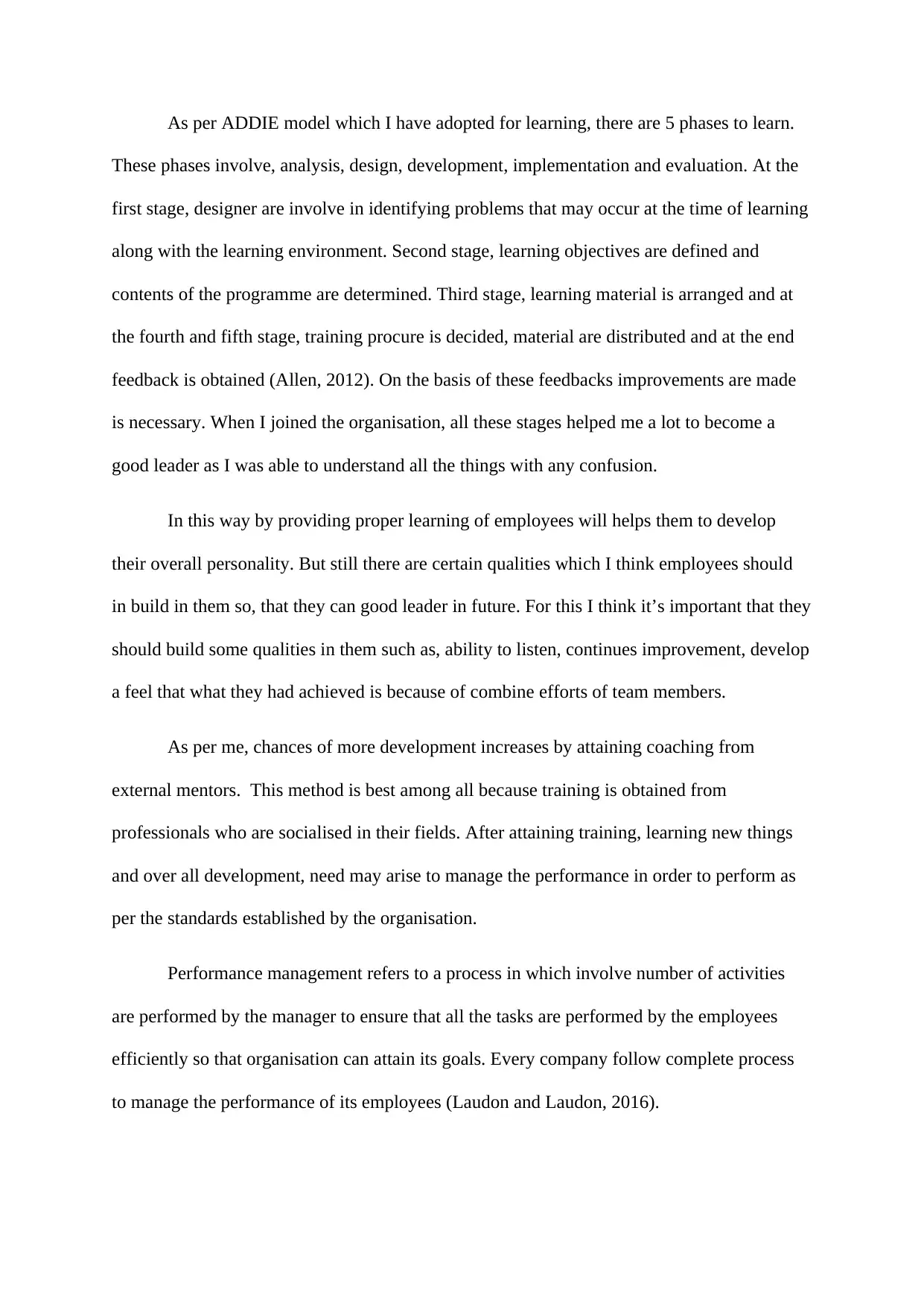
As per ADDIE model which I have adopted for learning, there are 5 phases to learn.
These phases involve, analysis, design, development, implementation and evaluation. At the
first stage, designer are involve in identifying problems that may occur at the time of learning
along with the learning environment. Second stage, learning objectives are defined and
contents of the programme are determined. Third stage, learning material is arranged and at
the fourth and fifth stage, training procure is decided, material are distributed and at the end
feedback is obtained (Allen, 2012). On the basis of these feedbacks improvements are made
is necessary. When I joined the organisation, all these stages helped me a lot to become a
good leader as I was able to understand all the things with any confusion.
In this way by providing proper learning of employees will helps them to develop
their overall personality. But still there are certain qualities which I think employees should
in build in them so, that they can good leader in future. For this I think it’s important that they
should build some qualities in them such as, ability to listen, continues improvement, develop
a feel that what they had achieved is because of combine efforts of team members.
As per me, chances of more development increases by attaining coaching from
external mentors. This method is best among all because training is obtained from
professionals who are socialised in their fields. After attaining training, learning new things
and over all development, need may arise to manage the performance in order to perform as
per the standards established by the organisation.
Performance management refers to a process in which involve number of activities
are performed by the manager to ensure that all the tasks are performed by the employees
efficiently so that organisation can attain its goals. Every company follow complete process
to manage the performance of its employees (Laudon and Laudon, 2016).
These phases involve, analysis, design, development, implementation and evaluation. At the
first stage, designer are involve in identifying problems that may occur at the time of learning
along with the learning environment. Second stage, learning objectives are defined and
contents of the programme are determined. Third stage, learning material is arranged and at
the fourth and fifth stage, training procure is decided, material are distributed and at the end
feedback is obtained (Allen, 2012). On the basis of these feedbacks improvements are made
is necessary. When I joined the organisation, all these stages helped me a lot to become a
good leader as I was able to understand all the things with any confusion.
In this way by providing proper learning of employees will helps them to develop
their overall personality. But still there are certain qualities which I think employees should
in build in them so, that they can good leader in future. For this I think it’s important that they
should build some qualities in them such as, ability to listen, continues improvement, develop
a feel that what they had achieved is because of combine efforts of team members.
As per me, chances of more development increases by attaining coaching from
external mentors. This method is best among all because training is obtained from
professionals who are socialised in their fields. After attaining training, learning new things
and over all development, need may arise to manage the performance in order to perform as
per the standards established by the organisation.
Performance management refers to a process in which involve number of activities
are performed by the manager to ensure that all the tasks are performed by the employees
efficiently so that organisation can attain its goals. Every company follow complete process
to manage the performance of its employees (Laudon and Laudon, 2016).

Basically three steps are involved in it. Process of performance management involve,
planning, monitoring and ends at reviewing and evaluating the performance. At the primary
phase, managers are involve in identifying current performance, new responsibilities, tries to
create link between job descriptions with work, developing proper work plan and training
objectives.
In the second phase, in order to assure that all the work performed by the employees
should be as per the standards drawn by the organisation, there performance is reviewed on
the daily basis. Managers keep their eagle eye over the progress made towards the objective,
hurdles that prevent employees to move forward and assure that they get proper support when
they required.
At the end feedback is given which can be positive or negative depending on the type
of work performed by the employee. I think in each and every organisation should be given
rewards to employees if, they had provided good services to the organisation. This will
motivate them to work hard. Whereas, negative feedback means that there is need to make
improvements. These improvements can be made ether by providing training or suggestions
so, that they can get back to track.
These feedbacks can be given individually especially when it comes to negative once.
Wherever as, if they special events should be organised on which rewards can be given. This
will provide recognition to employees.
planning, monitoring and ends at reviewing and evaluating the performance. At the primary
phase, managers are involve in identifying current performance, new responsibilities, tries to
create link between job descriptions with work, developing proper work plan and training
objectives.
In the second phase, in order to assure that all the work performed by the employees
should be as per the standards drawn by the organisation, there performance is reviewed on
the daily basis. Managers keep their eagle eye over the progress made towards the objective,
hurdles that prevent employees to move forward and assure that they get proper support when
they required.
At the end feedback is given which can be positive or negative depending on the type
of work performed by the employee. I think in each and every organisation should be given
rewards to employees if, they had provided good services to the organisation. This will
motivate them to work hard. Whereas, negative feedback means that there is need to make
improvements. These improvements can be made ether by providing training or suggestions
so, that they can get back to track.
These feedbacks can be given individually especially when it comes to negative once.
Wherever as, if they special events should be organised on which rewards can be given. This
will provide recognition to employees.
Paraphrase This Document
Need a fresh take? Get an instant paraphrase of this document with our AI Paraphraser
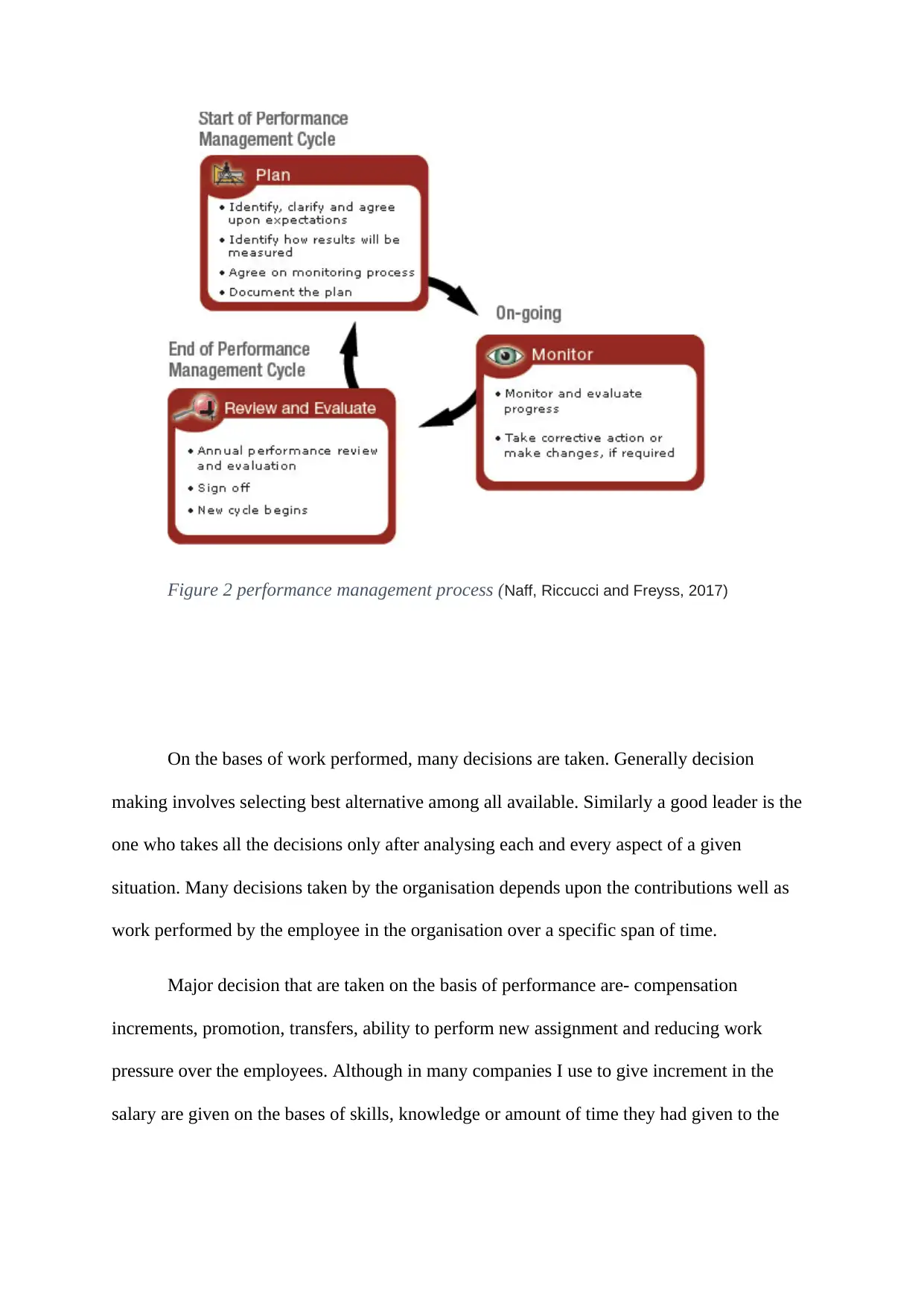
Figure 2 performance management process (Naff, Riccucci and Freyss, 2017)
On the bases of work performed, many decisions are taken. Generally decision
making involves selecting best alternative among all available. Similarly a good leader is the
one who takes all the decisions only after analysing each and every aspect of a given
situation. Many decisions taken by the organisation depends upon the contributions well as
work performed by the employee in the organisation over a specific span of time.
Major decision that are taken on the basis of performance are- compensation
increments, promotion, transfers, ability to perform new assignment and reducing work
pressure over the employees. Although in many companies I use to give increment in the
salary are given on the bases of skills, knowledge or amount of time they had given to the
On the bases of work performed, many decisions are taken. Generally decision
making involves selecting best alternative among all available. Similarly a good leader is the
one who takes all the decisions only after analysing each and every aspect of a given
situation. Many decisions taken by the organisation depends upon the contributions well as
work performed by the employee in the organisation over a specific span of time.
Major decision that are taken on the basis of performance are- compensation
increments, promotion, transfers, ability to perform new assignment and reducing work
pressure over the employees. Although in many companies I use to give increment in the
salary are given on the bases of skills, knowledge or amount of time they had given to the
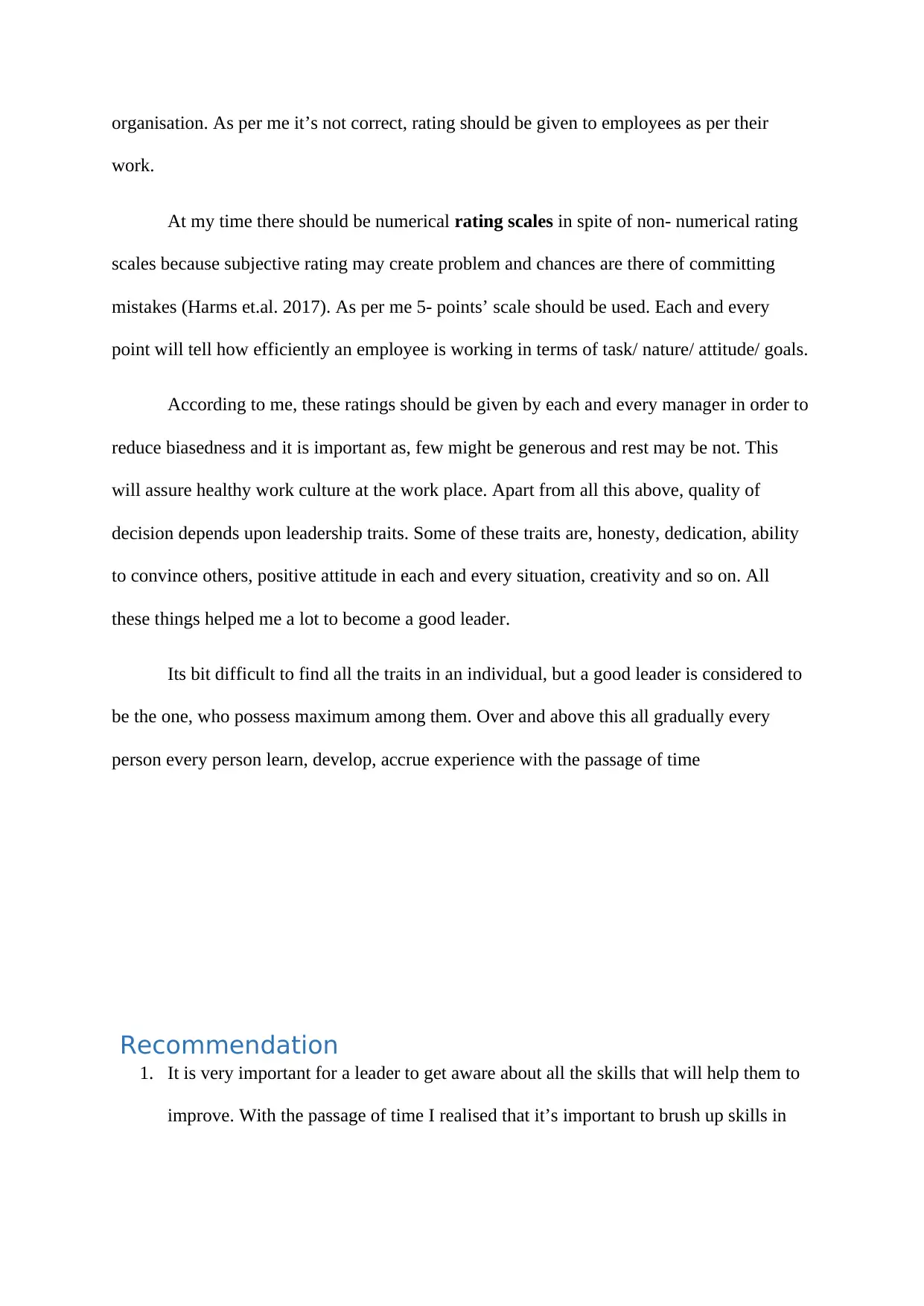
organisation. As per me it’s not correct, rating should be given to employees as per their
work.
At my time there should be numerical rating scales in spite of non- numerical rating
scales because subjective rating may create problem and chances are there of committing
mistakes (Harms et.al. 2017). As per me 5- points’ scale should be used. Each and every
point will tell how efficiently an employee is working in terms of task/ nature/ attitude/ goals.
According to me, these ratings should be given by each and every manager in order to
reduce biasedness and it is important as, few might be generous and rest may be not. This
will assure healthy work culture at the work place. Apart from all this above, quality of
decision depends upon leadership traits. Some of these traits are, honesty, dedication, ability
to convince others, positive attitude in each and every situation, creativity and so on. All
these things helped me a lot to become a good leader.
Its bit difficult to find all the traits in an individual, but a good leader is considered to
be the one, who possess maximum among them. Over and above this all gradually every
person every person learn, develop, accrue experience with the passage of time
Recommendation
1. It is very important for a leader to get aware about all the skills that will help them to
improve. With the passage of time I realised that it’s important to brush up skills in
work.
At my time there should be numerical rating scales in spite of non- numerical rating
scales because subjective rating may create problem and chances are there of committing
mistakes (Harms et.al. 2017). As per me 5- points’ scale should be used. Each and every
point will tell how efficiently an employee is working in terms of task/ nature/ attitude/ goals.
According to me, these ratings should be given by each and every manager in order to
reduce biasedness and it is important as, few might be generous and rest may be not. This
will assure healthy work culture at the work place. Apart from all this above, quality of
decision depends upon leadership traits. Some of these traits are, honesty, dedication, ability
to convince others, positive attitude in each and every situation, creativity and so on. All
these things helped me a lot to become a good leader.
Its bit difficult to find all the traits in an individual, but a good leader is considered to
be the one, who possess maximum among them. Over and above this all gradually every
person every person learn, develop, accrue experience with the passage of time
Recommendation
1. It is very important for a leader to get aware about all the skills that will help them to
improve. With the passage of time I realised that it’s important to brush up skills in
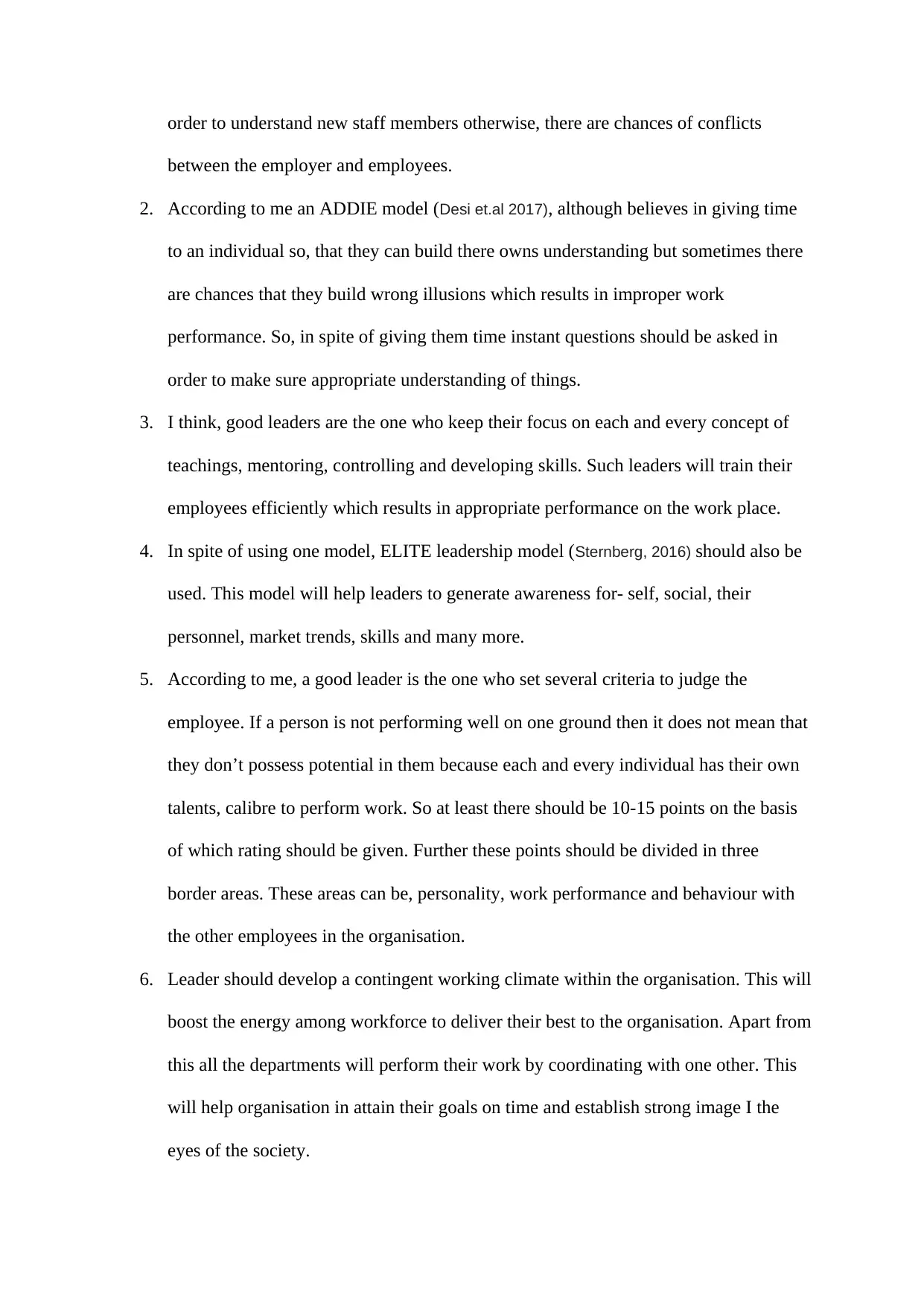
order to understand new staff members otherwise, there are chances of conflicts
between the employer and employees.
2. According to me an ADDIE model (Desi et.al 2017), although believes in giving time
to an individual so, that they can build there owns understanding but sometimes there
are chances that they build wrong illusions which results in improper work
performance. So, in spite of giving them time instant questions should be asked in
order to make sure appropriate understanding of things.
3. I think, good leaders are the one who keep their focus on each and every concept of
teachings, mentoring, controlling and developing skills. Such leaders will train their
employees efficiently which results in appropriate performance on the work place.
4. In spite of using one model, ELITE leadership model (Sternberg, 2016) should also be
used. This model will help leaders to generate awareness for- self, social, their
personnel, market trends, skills and many more.
5. According to me, a good leader is the one who set several criteria to judge the
employee. If a person is not performing well on one ground then it does not mean that
they don’t possess potential in them because each and every individual has their own
talents, calibre to perform work. So at least there should be 10-15 points on the basis
of which rating should be given. Further these points should be divided in three
border areas. These areas can be, personality, work performance and behaviour with
the other employees in the organisation.
6. Leader should develop a contingent working climate within the organisation. This will
boost the energy among workforce to deliver their best to the organisation. Apart from
this all the departments will perform their work by coordinating with one other. This
will help organisation in attain their goals on time and establish strong image I the
eyes of the society.
between the employer and employees.
2. According to me an ADDIE model (Desi et.al 2017), although believes in giving time
to an individual so, that they can build there owns understanding but sometimes there
are chances that they build wrong illusions which results in improper work
performance. So, in spite of giving them time instant questions should be asked in
order to make sure appropriate understanding of things.
3. I think, good leaders are the one who keep their focus on each and every concept of
teachings, mentoring, controlling and developing skills. Such leaders will train their
employees efficiently which results in appropriate performance on the work place.
4. In spite of using one model, ELITE leadership model (Sternberg, 2016) should also be
used. This model will help leaders to generate awareness for- self, social, their
personnel, market trends, skills and many more.
5. According to me, a good leader is the one who set several criteria to judge the
employee. If a person is not performing well on one ground then it does not mean that
they don’t possess potential in them because each and every individual has their own
talents, calibre to perform work. So at least there should be 10-15 points on the basis
of which rating should be given. Further these points should be divided in three
border areas. These areas can be, personality, work performance and behaviour with
the other employees in the organisation.
6. Leader should develop a contingent working climate within the organisation. This will
boost the energy among workforce to deliver their best to the organisation. Apart from
this all the departments will perform their work by coordinating with one other. This
will help organisation in attain their goals on time and establish strong image I the
eyes of the society.
Secure Best Marks with AI Grader
Need help grading? Try our AI Grader for instant feedback on your assignments.
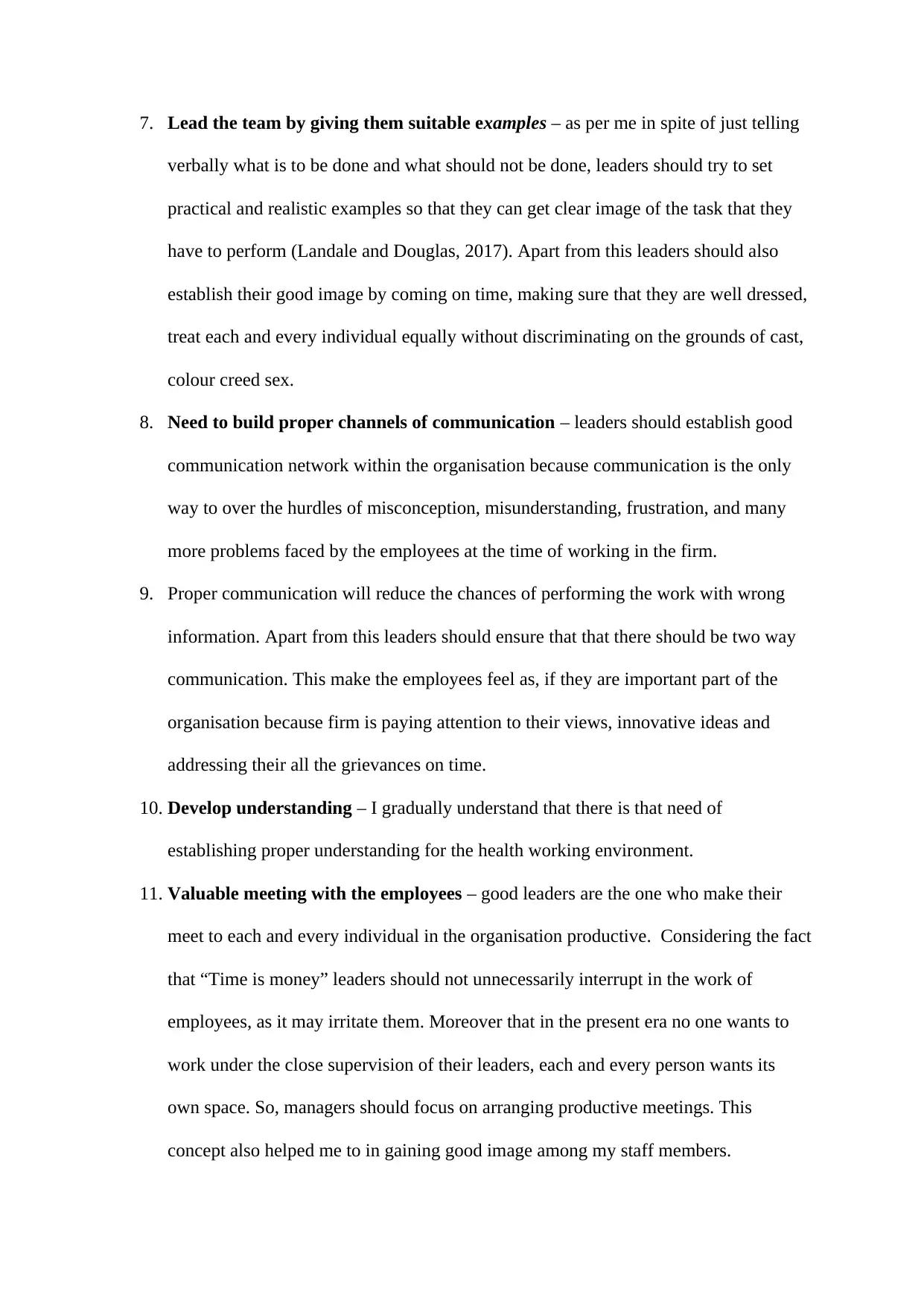
7. Lead the team by giving them suitable examples – as per me in spite of just telling
verbally what is to be done and what should not be done, leaders should try to set
practical and realistic examples so that they can get clear image of the task that they
have to perform (Landale and Douglas, 2017). Apart from this leaders should also
establish their good image by coming on time, making sure that they are well dressed,
treat each and every individual equally without discriminating on the grounds of cast,
colour creed sex.
8. Need to build proper channels of communication – leaders should establish good
communication network within the organisation because communication is the only
way to over the hurdles of misconception, misunderstanding, frustration, and many
more problems faced by the employees at the time of working in the firm.
9. Proper communication will reduce the chances of performing the work with wrong
information. Apart from this leaders should ensure that that there should be two way
communication. This make the employees feel as, if they are important part of the
organisation because firm is paying attention to their views, innovative ideas and
addressing their all the grievances on time.
10. Develop understanding – I gradually understand that there is that need of
establishing proper understanding for the health working environment.
11. Valuable meeting with the employees – good leaders are the one who make their
meet to each and every individual in the organisation productive. Considering the fact
that “Time is money” leaders should not unnecessarily interrupt in the work of
employees, as it may irritate them. Moreover that in the present era no one wants to
work under the close supervision of their leaders, each and every person wants its
own space. So, managers should focus on arranging productive meetings. This
concept also helped me to in gaining good image among my staff members.
verbally what is to be done and what should not be done, leaders should try to set
practical and realistic examples so that they can get clear image of the task that they
have to perform (Landale and Douglas, 2017). Apart from this leaders should also
establish their good image by coming on time, making sure that they are well dressed,
treat each and every individual equally without discriminating on the grounds of cast,
colour creed sex.
8. Need to build proper channels of communication – leaders should establish good
communication network within the organisation because communication is the only
way to over the hurdles of misconception, misunderstanding, frustration, and many
more problems faced by the employees at the time of working in the firm.
9. Proper communication will reduce the chances of performing the work with wrong
information. Apart from this leaders should ensure that that there should be two way
communication. This make the employees feel as, if they are important part of the
organisation because firm is paying attention to their views, innovative ideas and
addressing their all the grievances on time.
10. Develop understanding – I gradually understand that there is that need of
establishing proper understanding for the health working environment.
11. Valuable meeting with the employees – good leaders are the one who make their
meet to each and every individual in the organisation productive. Considering the fact
that “Time is money” leaders should not unnecessarily interrupt in the work of
employees, as it may irritate them. Moreover that in the present era no one wants to
work under the close supervision of their leaders, each and every person wants its
own space. So, managers should focus on arranging productive meetings. This
concept also helped me to in gaining good image among my staff members.

12. Always be curious to learn new things – if the leader is flexible enough to accept
new changes, then it won’t be difficult to convince staff members to adopt new things.
Curiosity is one of the most important trait of the good leader. If a person is new
curious to learn anything new then it would be quite difficulty for the organisation to
maintain their position in the market.
13. Accept all mistakes without any hesitation – I took long time to accept the fact that
I won’t become small if I’ll say sorry on mine faults (Prince Et.al. 2017). Initially I
use to hide my mistakes from subordinates but soon I realised that, people will respect
me more if they will find me accepting mine mistake if I commit them this will not
only helps me to build strong image but also develop an ability to learn new things
from anyone without any hesitation (ENERENCZI, 2017).
Conclusion
Finally, I can say that good leaders are not born, anyone can become a leader
(Cashman, K., 2017) after acquire the set a set range of qualities such as, understanding
employees, develop faith among the team members, establishing coordination
between different departments and so on. These all the theories helped me a lot to
build an image of good leader in the eyes of society.
Benchmarks are also established by the leaders but, those at the time of establishing
them they should assure that, standards should not be fixed to high or too low. If the
standards are set too low then employees will not attain satisfaction even after attain
them whereas, if the standards are too high then they won’t be able to attain them and
this will make them feel frustrated and irritated. This all will results in increase in
turnover of the organisation.
new changes, then it won’t be difficult to convince staff members to adopt new things.
Curiosity is one of the most important trait of the good leader. If a person is new
curious to learn anything new then it would be quite difficulty for the organisation to
maintain their position in the market.
13. Accept all mistakes without any hesitation – I took long time to accept the fact that
I won’t become small if I’ll say sorry on mine faults (Prince Et.al. 2017). Initially I
use to hide my mistakes from subordinates but soon I realised that, people will respect
me more if they will find me accepting mine mistake if I commit them this will not
only helps me to build strong image but also develop an ability to learn new things
from anyone without any hesitation (ENERENCZI, 2017).
Conclusion
Finally, I can say that good leaders are not born, anyone can become a leader
(Cashman, K., 2017) after acquire the set a set range of qualities such as, understanding
employees, develop faith among the team members, establishing coordination
between different departments and so on. These all the theories helped me a lot to
build an image of good leader in the eyes of society.
Benchmarks are also established by the leaders but, those at the time of establishing
them they should assure that, standards should not be fixed to high or too low. If the
standards are set too low then employees will not attain satisfaction even after attain
them whereas, if the standards are too high then they won’t be able to attain them and
this will make them feel frustrated and irritated. This all will results in increase in
turnover of the organisation.

Paraphrase This Document
Need a fresh take? Get an instant paraphrase of this document with our AI Paraphraser
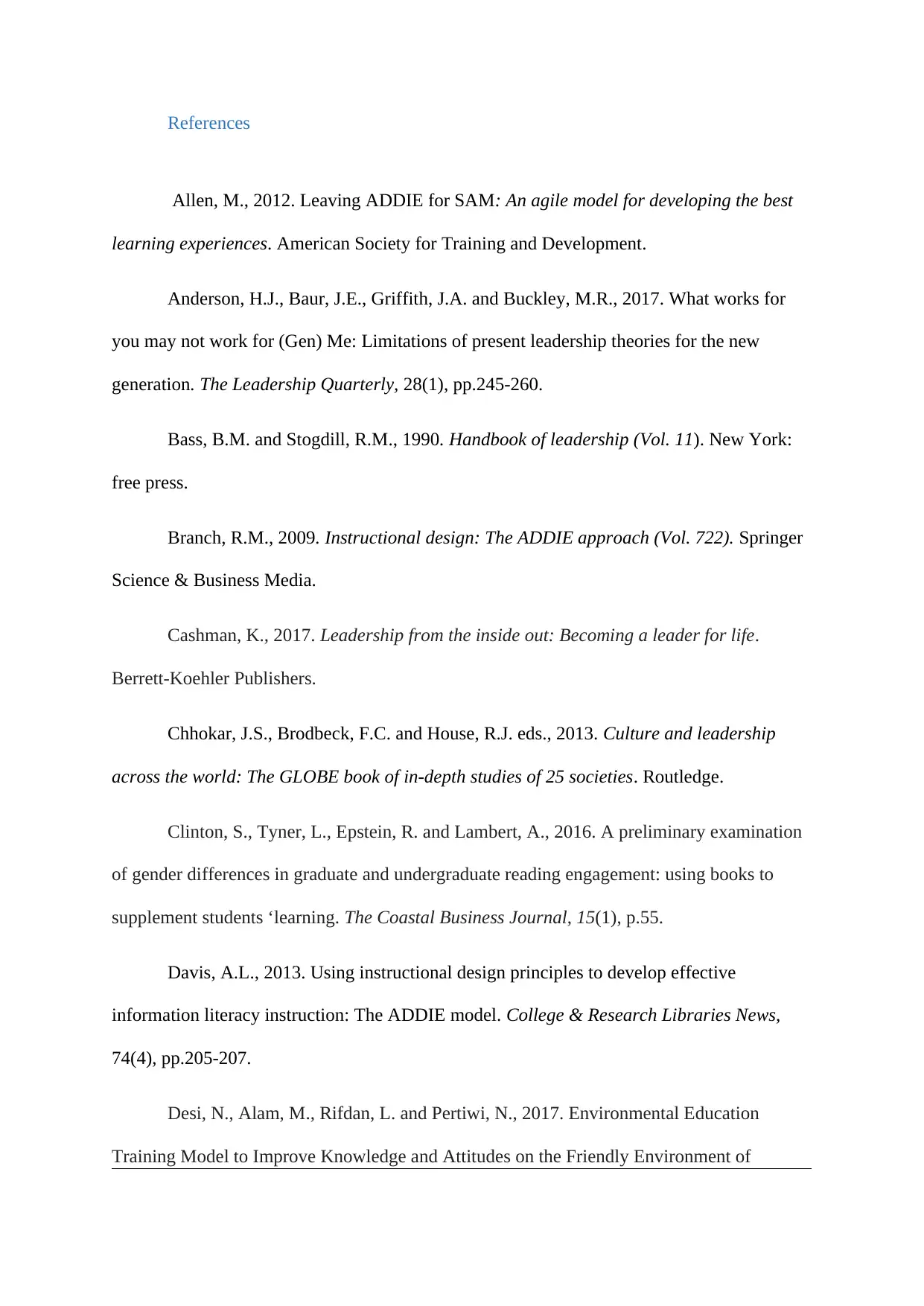
References
Allen, M., 2012. Leaving ADDIE for SAM: An agile model for developing the best
learning experiences. American Society for Training and Development.
Anderson, H.J., Baur, J.E., Griffith, J.A. and Buckley, M.R., 2017. What works for
you may not work for (Gen) Me: Limitations of present leadership theories for the new
generation. The Leadership Quarterly, 28(1), pp.245-260.
Bass, B.M. and Stogdill, R.M., 1990. Handbook of leadership (Vol. 11). New York:
free press.
Branch, R.M., 2009. Instructional design: The ADDIE approach (Vol. 722). Springer
Science & Business Media.
Cashman, K., 2017. Leadership from the inside out: Becoming a leader for life.
Berrett-Koehler Publishers.
Chhokar, J.S., Brodbeck, F.C. and House, R.J. eds., 2013. Culture and leadership
across the world: The GLOBE book of in-depth studies of 25 societies. Routledge.
Clinton, S., Tyner, L., Epstein, R. and Lambert, A., 2016. A preliminary examination
of gender differences in graduate and undergraduate reading engagement: using books to
supplement students ‘learning. The Coastal Business Journal, 15(1), p.55.
Davis, A.L., 2013. Using instructional design principles to develop effective
information literacy instruction: The ADDIE model. College & Research Libraries News,
74(4), pp.205-207.
Desi, N., Alam, M., Rifdan, L. and Pertiwi, N., 2017. Environmental Education
Training Model to Improve Knowledge and Attitudes on the Friendly Environment of
Allen, M., 2012. Leaving ADDIE for SAM: An agile model for developing the best
learning experiences. American Society for Training and Development.
Anderson, H.J., Baur, J.E., Griffith, J.A. and Buckley, M.R., 2017. What works for
you may not work for (Gen) Me: Limitations of present leadership theories for the new
generation. The Leadership Quarterly, 28(1), pp.245-260.
Bass, B.M. and Stogdill, R.M., 1990. Handbook of leadership (Vol. 11). New York:
free press.
Branch, R.M., 2009. Instructional design: The ADDIE approach (Vol. 722). Springer
Science & Business Media.
Cashman, K., 2017. Leadership from the inside out: Becoming a leader for life.
Berrett-Koehler Publishers.
Chhokar, J.S., Brodbeck, F.C. and House, R.J. eds., 2013. Culture and leadership
across the world: The GLOBE book of in-depth studies of 25 societies. Routledge.
Clinton, S., Tyner, L., Epstein, R. and Lambert, A., 2016. A preliminary examination
of gender differences in graduate and undergraduate reading engagement: using books to
supplement students ‘learning. The Coastal Business Journal, 15(1), p.55.
Davis, A.L., 2013. Using instructional design principles to develop effective
information literacy instruction: The ADDIE model. College & Research Libraries News,
74(4), pp.205-207.
Desi, N., Alam, M., Rifdan, L. and Pertiwi, N., 2017. Environmental Education
Training Model to Improve Knowledge and Attitudes on the Friendly Environment of
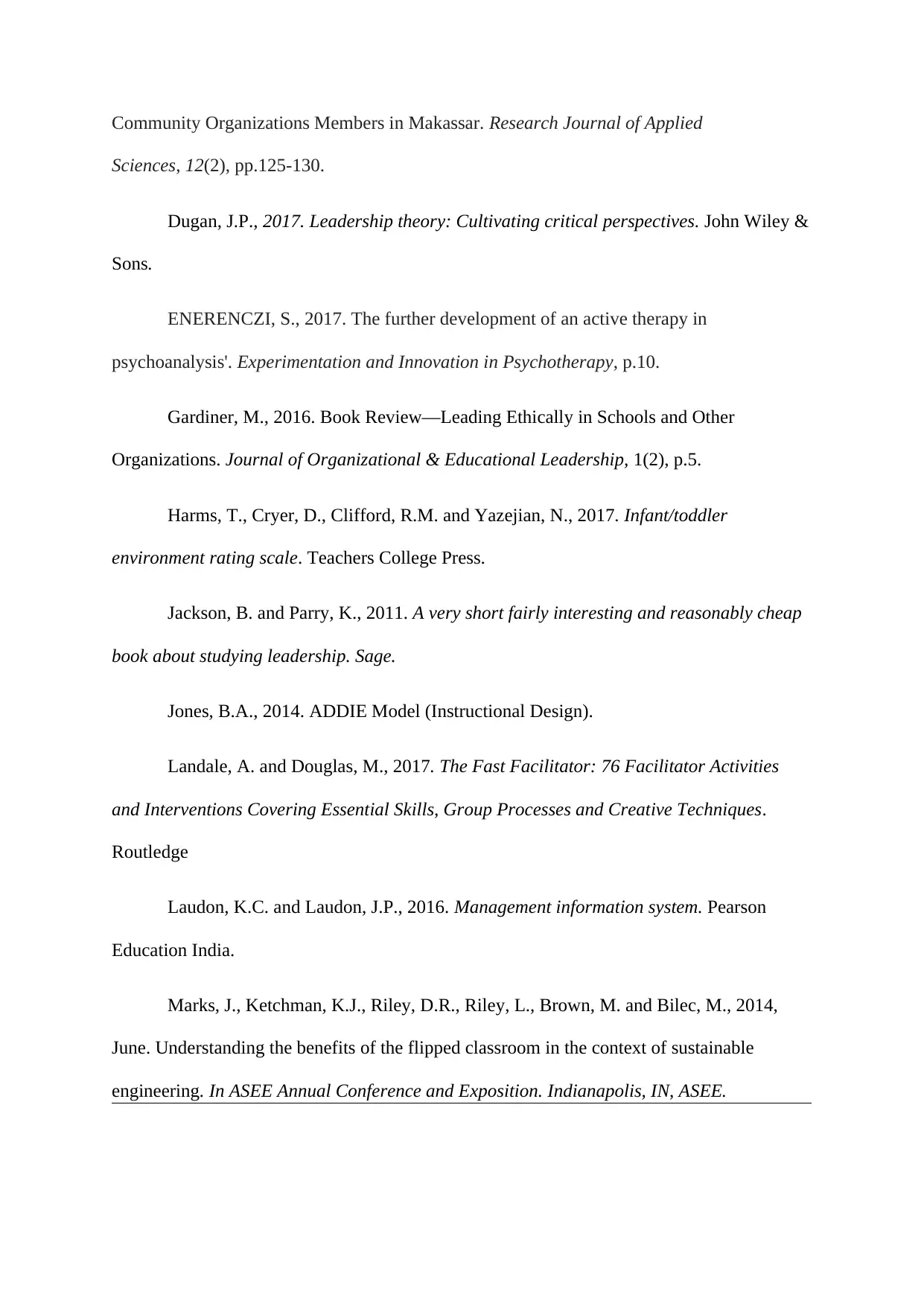
Community Organizations Members in Makassar. Research Journal of Applied
Sciences, 12(2), pp.125-130.
Dugan, J.P., 2017. Leadership theory: Cultivating critical perspectives. John Wiley &
Sons.
ENERENCZI, S., 2017. The further development of an active therapy in
psychoanalysis'. Experimentation and Innovation in Psychotherapy, p.10.
Gardiner, M., 2016. Book Review—Leading Ethically in Schools and Other
Organizations. Journal of Organizational & Educational Leadership, 1(2), p.5.
Harms, T., Cryer, D., Clifford, R.M. and Yazejian, N., 2017. Infant/toddler
environment rating scale. Teachers College Press.
Jackson, B. and Parry, K., 2011. A very short fairly interesting and reasonably cheap
book about studying leadership. Sage.
Jones, B.A., 2014. ADDIE Model (Instructional Design).
Landale, A. and Douglas, M., 2017. The Fast Facilitator: 76 Facilitator Activities
and Interventions Covering Essential Skills, Group Processes and Creative Techniques.
Routledge
Laudon, K.C. and Laudon, J.P., 2016. Management information system. Pearson
Education India.
Marks, J., Ketchman, K.J., Riley, D.R., Riley, L., Brown, M. and Bilec, M., 2014,
June. Understanding the benefits of the flipped classroom in the context of sustainable
engineering. In ASEE Annual Conference and Exposition. Indianapolis, IN, ASEE.
Sciences, 12(2), pp.125-130.
Dugan, J.P., 2017. Leadership theory: Cultivating critical perspectives. John Wiley &
Sons.
ENERENCZI, S., 2017. The further development of an active therapy in
psychoanalysis'. Experimentation and Innovation in Psychotherapy, p.10.
Gardiner, M., 2016. Book Review—Leading Ethically in Schools and Other
Organizations. Journal of Organizational & Educational Leadership, 1(2), p.5.
Harms, T., Cryer, D., Clifford, R.M. and Yazejian, N., 2017. Infant/toddler
environment rating scale. Teachers College Press.
Jackson, B. and Parry, K., 2011. A very short fairly interesting and reasonably cheap
book about studying leadership. Sage.
Jones, B.A., 2014. ADDIE Model (Instructional Design).
Landale, A. and Douglas, M., 2017. The Fast Facilitator: 76 Facilitator Activities
and Interventions Covering Essential Skills, Group Processes and Creative Techniques.
Routledge
Laudon, K.C. and Laudon, J.P., 2016. Management information system. Pearson
Education India.
Marks, J., Ketchman, K.J., Riley, D.R., Riley, L., Brown, M. and Bilec, M., 2014,
June. Understanding the benefits of the flipped classroom in the context of sustainable
engineering. In ASEE Annual Conference and Exposition. Indianapolis, IN, ASEE.
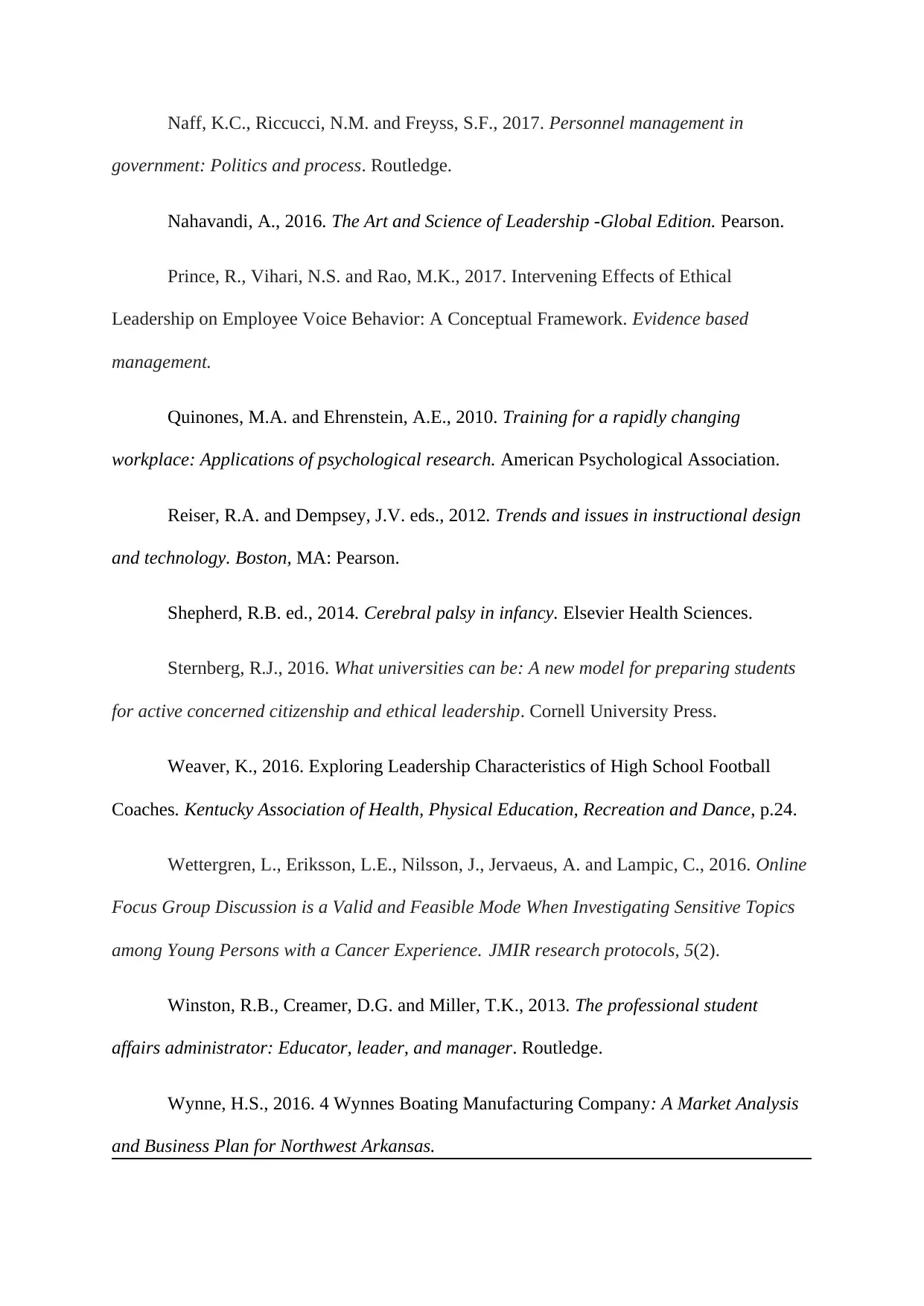
Naff, K.C., Riccucci, N.M. and Freyss, S.F., 2017. Personnel management in
government: Politics and process. Routledge.
Nahavandi, A., 2016. The Art and Science of Leadership -Global Edition. Pearson.
Prince, R., Vihari, N.S. and Rao, M.K., 2017. Intervening Effects of Ethical
Leadership on Employee Voice Behavior: A Conceptual Framework. Evidence based
management.
Quinones, M.A. and Ehrenstein, A.E., 2010. Training for a rapidly changing
workplace: Applications of psychological research. American Psychological Association.
Reiser, R.A. and Dempsey, J.V. eds., 2012. Trends and issues in instructional design
and technology. Boston, MA: Pearson.
Shepherd, R.B. ed., 2014. Cerebral palsy in infancy. Elsevier Health Sciences.
Sternberg, R.J., 2016. What universities can be: A new model for preparing students
for active concerned citizenship and ethical leadership. Cornell University Press.
Weaver, K., 2016. Exploring Leadership Characteristics of High School Football
Coaches. Kentucky Association of Health, Physical Education, Recreation and Dance, p.24.
Wettergren, L., Eriksson, L.E., Nilsson, J., Jervaeus, A. and Lampic, C., 2016. Online
Focus Group Discussion is a Valid and Feasible Mode When Investigating Sensitive Topics
among Young Persons with a Cancer Experience. JMIR research protocols, 5(2).
Winston, R.B., Creamer, D.G. and Miller, T.K., 2013. The professional student
affairs administrator: Educator, leader, and manager. Routledge.
Wynne, H.S., 2016. 4 Wynnes Boating Manufacturing Company: A Market Analysis
and Business Plan for Northwest Arkansas.
government: Politics and process. Routledge.
Nahavandi, A., 2016. The Art and Science of Leadership -Global Edition. Pearson.
Prince, R., Vihari, N.S. and Rao, M.K., 2017. Intervening Effects of Ethical
Leadership on Employee Voice Behavior: A Conceptual Framework. Evidence based
management.
Quinones, M.A. and Ehrenstein, A.E., 2010. Training for a rapidly changing
workplace: Applications of psychological research. American Psychological Association.
Reiser, R.A. and Dempsey, J.V. eds., 2012. Trends and issues in instructional design
and technology. Boston, MA: Pearson.
Shepherd, R.B. ed., 2014. Cerebral palsy in infancy. Elsevier Health Sciences.
Sternberg, R.J., 2016. What universities can be: A new model for preparing students
for active concerned citizenship and ethical leadership. Cornell University Press.
Weaver, K., 2016. Exploring Leadership Characteristics of High School Football
Coaches. Kentucky Association of Health, Physical Education, Recreation and Dance, p.24.
Wettergren, L., Eriksson, L.E., Nilsson, J., Jervaeus, A. and Lampic, C., 2016. Online
Focus Group Discussion is a Valid and Feasible Mode When Investigating Sensitive Topics
among Young Persons with a Cancer Experience. JMIR research protocols, 5(2).
Winston, R.B., Creamer, D.G. and Miller, T.K., 2013. The professional student
affairs administrator: Educator, leader, and manager. Routledge.
Wynne, H.S., 2016. 4 Wynnes Boating Manufacturing Company: A Market Analysis
and Business Plan for Northwest Arkansas.
1 out of 16
Your All-in-One AI-Powered Toolkit for Academic Success.
+13062052269
info@desklib.com
Available 24*7 on WhatsApp / Email
![[object Object]](/_next/static/media/star-bottom.7253800d.svg)
Unlock your academic potential
© 2024 | Zucol Services PVT LTD | All rights reserved.




